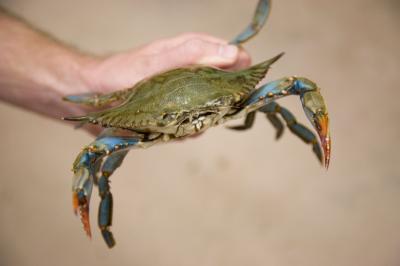Those two crooked beady eyes peeking out of a the shell do more than just help blue crabs spot food in the murky waters of the Chesapeake Bay. They also produce important hormones responsible for the growth and development of a crab from an adolescent into a full-fledged adult. Scientists at the Institute of Marine and Environmental Technology in Maryland recently discovered a new hormone in those eyestalks responsible for forming body parts that make it possible for female crabs to mate and raise young.
“This is the first definitive evidence for the presence of a female-specific hormone in crabs that regulates the development of structures essential for mating and caring for their eggs,” said author J. Sook Chung, an associate professor with the University of Maryland Center for Environmental Science. “This hormone is required for maternal care.”
Scientists found that this crustacean female sex hormone (CSFH), present in the eyestalk of female blue crabs, or Calinectes sapidus, is integral to the maturation of the crab and development of reproductive structures needed for brooding and mating.
“For the first time in crustaceans, a substance that is critically involved in the control of expression of relevant adult anatomic features in females has been identified,” said Russell Hill, Director of the Institute of Marine and Environmental Technology. “This is very significant basic research on a molecular level that also may have practical application in the future, as with most of the important research at IMET”.
Female crabs mate only once in their lives, at the very moment that they molt for the final time and reach maturity. The female sex hormones trigger the development of a pair of special receptacles, called spemathecae, that store microscopic packets of sperm, or spermatophores, from the male crab. After mating, the sperm lives in these sacs for up to two years and will be used by the female crab several times to produce more fertilized eggs.
The hormone also triggers the development of hair-like external structures that hold fertilized eggs outside the female’s body. The female crab extrudes more than two million eggs into a sponge-like mass that remains attached to her abdomen until the larvae emerge.


